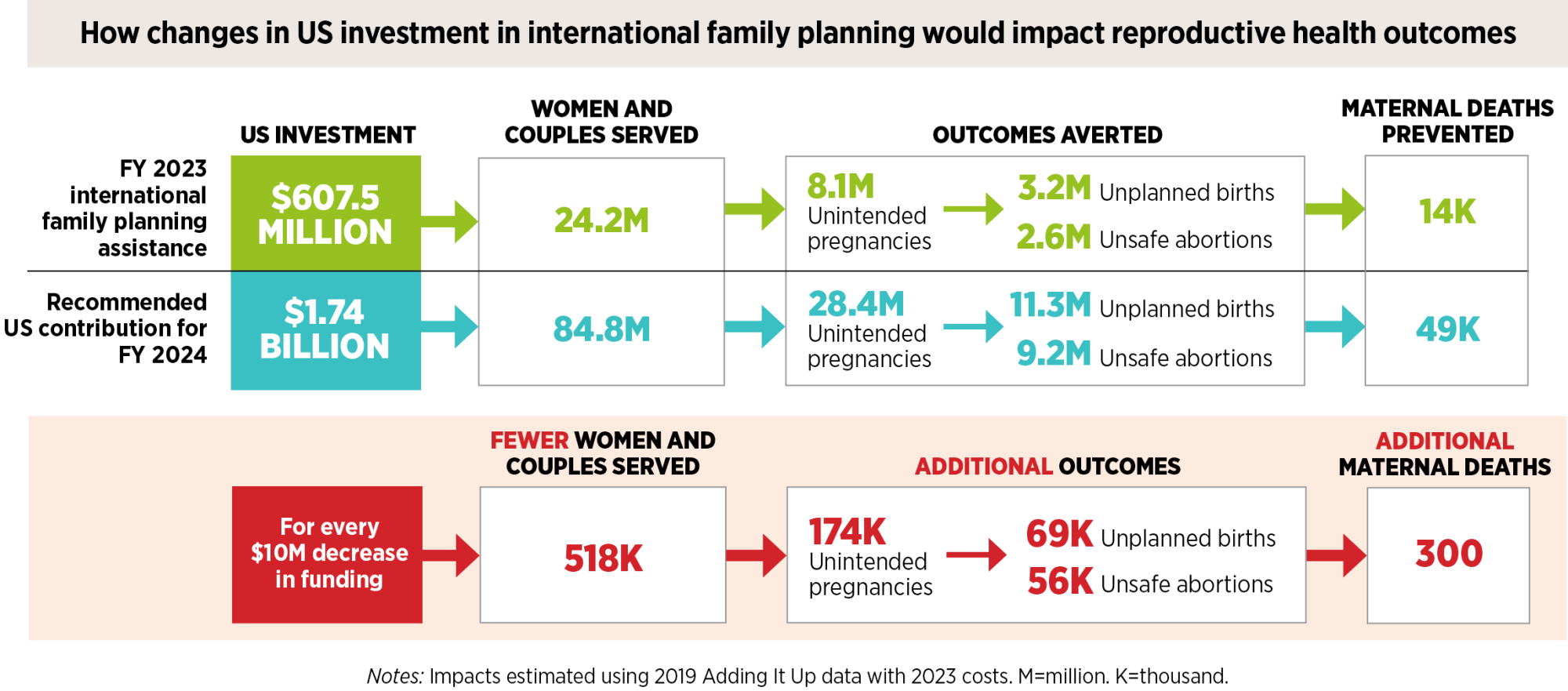Investments in sexual and reproductive health and rights have far-reaching and measurable benefits. By helping to address people’s reproductive health needs, such investments not only promote health and well-being throughout people’s lives but also contribute to improvements in gender equity, political stability, economic development and environmental sustainability.1
US Support for International Family Planning
Family planning is a fundamental component of comprehensive sexual and reproductive health and rights, as defined by the Guttmacher-Lancet Commission. The United States supports family planning services through financial assistance and coordination of programs across multilateral entities. The U.S. Agency for International Development (USAID) plays a critical role in increasing access to family planning information, services and supplies in more than 30 countries where the need is greatest. USAID's family planning program supports service delivery, contraceptive provision, and monitoring and evaluation, among other activities. It also seeks to integrate family planning with maternal and child health interventions, HIV programming, and efforts to end child marriage and gender-based violence.
To complement its bilateral work, USAID collaborates closely with the United Nations Population Fund (UNFPA), a multilateral organization that focuses specifically on the delivery of family planning services and maternal and child health care in more than 150 countries and territories. The Trump administration withheld funding for UNFPA, causing a significant disruption to the delivery of services. In 2021, the Biden administration reinstated funding. This renewed investment was critical to supporting UNFPA’s work.
Much more needs to be done to increase support and address unmet need for family planning and reproductive health services. For federal fiscal year (FY) 2023, Congress appropriated $607.5 million in US assistance for global family planning and reproductive health programs, including $32.5 million for UNFPA. This represents the 14th consecutive year of level funding. While the United States remains a leading donor in family planning, this stagnation in funding represents more than a decade’s worth of missed opportunities to support growing contraceptive needs globally.
Impact of US Investment
Increased US investment in family planning is urgently needed to meet the rising costs of providing services and to reach the large number of those with an unmet need for modern contraceptive care. Advocates recommend that the United States provide $1.74 billion for international bilateral and multilateral family planning and reproductive health programs, including $116 million for UNFPA.2 These levels represent the annual sum needed for the United States to contribute its fair share of the cost of addressing family planning needs worldwide.
The graphic shows the benefits of the current and increased US investments in terms of the estimated number of unintended pregnancies, unplanned births, unsafe abortions and maternal deaths averted. If the United States increased its investment to the recommended $1.74 billion, compared with the current investment, the programs would serve an additional 60.6 million women and couples, the estimated number of unintended pregnancies averted would increase from 8.1 million to 28.4 million and the number of maternal deaths prevented would increase from 14,000 to 49,000.
Unfortunately, some policymakers have proposed drastic cuts in funding or want to withhold funding for UNFPA once again, which would be devastating for people’s health outcomes. Even seemingly small cuts in international family planning assistance would lead to increases in preventable outcomes around the world. The graphic also demonstrates how every $10 million decrease in funding below current levels would deny services to 518,000 women and couples and increase unintended pregnancies by 174,000, unplanned births by 69,000 and unsafe abortions by 56,000.
Methodology and Sources
Estimates of the impacts of current and increased investment were calculated by dividing family planning allocations to countries and USAID regional offices for FY 2022 by estimated 2019 country-level per-user impacts, which come from the most recent comprehensive analysis of costs and impacts of family planning in low- and middle-income countries.3–5 Impacts per user were estimated as the difference between the annual number of events that would occur if all women wanting to avoid pregnancy used modern methods and the number that would occur if they relied on traditional or no methods.4
Country-level per-user costs were updated to 2023. Funding allocated to regional offices, rather than countries, was included if some or all of the funding was allocated to countries, determined using information from USAID.6 It was estimated that 12% of core funding to UNFPA went to family planning–specific activities.7
Just the Numbers estimates for 2023 are not directly comparable to prior iterations of this analysis.

